5G VoNR is coming, so let’s talk about this new technology today.
Let’s start with a brief review of the history of voice service evolution.
The past is the mirror of the future. Before understanding VoNR in the 5G era, it is necessary to review the history of voice service evolution in mobile networks.
In the 2G and 3G era, voice services used CS (Circuited Switched) technology, which means that cell phones need to establish an exclusive line in the network before making a call and not remove it until the call is over.
This old technology has disadvantages such as resource consumption, complex network configuration, and low efficiency.
Entering the 4G all-IP era, as only packet domain PS is available, traditional CS voice is no longer supported, so two schemes, CSFB and VoLTE, are proposed to support voice services.
CSFB, i.e. CS FallBack, means that when a cell phone initiates a voice call in the 4G network, it falls back from the LTE network to the 2/3G network, completes the voice call with the help of the CS circuit domain of 2G/3G network, and returns to 4G LTE after the call.
VoLTE, or Voice over LTE, refers to the direct provision of IP-based voice services by LTE networks through the introduction of IMS. VoLTE is also known as VoIP managed by IMS and carried on 4G LTE networks.
VoLTE encapsulates voice services into IP packets for transmission like express packets without exclusive use of resources, which significantly improves network efficiency. More importantly, VoLTE also offers unprecedented improvements in voice quality and reduced call setup times.
VoLTE adopts AMR-WB (Adaptive Multi-rate-Wideband) voice coding technology, which greatly improves the coding rate compared with 2G and 3G era, and increases the voice bandwidth range from 300Hz-3400Hz to 50Hz-7000Hz.
Thus providing clearer sound quality and a wider sound range, making the voice quality of the mobile network comparable to the experience of listening to the radio for the first time.
When dialing, it takes about 6-8 seconds for the 3G network to connect, while VoLTE only takes about 2-3 seconds to connect.
Therefore, VoLTE is a revolutionary technological evolution in the history of mobile network voice service development, both in terms of technical architecture and user experience.
Will 5G voice make another huge leap like VoLTE, and what does VoNR look like in the 5G era?
What does 5G VoNR mean?
VoNR is the ultimate 5G voice solution
First, let’s answer the first question: voice in the 5G era will never be as revolutionary as VoLTE. In fact, 5G systems do not provide a separate technical solution for voice services and are designed primarily to support the continued evolution of VoLTE.
As we all know, IMS is the brain of VoLTE, which is actually an end-to-end VoIP connection controlled and managed by the IMS core network.
It is because IMS can achieve end-to-end QoS management for a voice that the voice quality of VoLTE is far better than the best-effort Internet VoIP.
When 3GPP defined 5G in version R15, it was clear that 5G would still be based on IMS for voice services, and the design principle that 5G deployment should minimize the impact on existing IMS was established.
Based on these principles, 5G voice provides three deployment options, VoLTE, EPS Fallback, and VoNR, according to the two major deployment options of 5G NSA and SA.
What is VoLTE (NSA networking)?
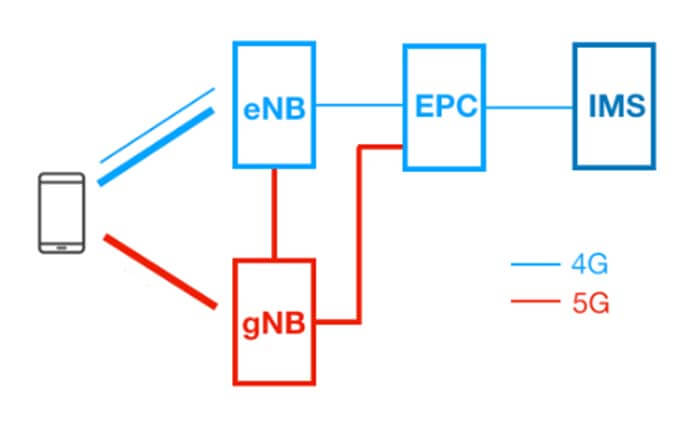
Under NSA networking, 5G NR is added to the existing 4G network as a capacity extension and follows the 4G core network EPC, where the 4G network remains the primary control network and 5G NR supports only best-effort data transmission.
In such an architecture, voice services are still provided by the existing 4G IMS/VoLTE network with very minor or no changes.
Seamless switching of voice calls between VoLTE and 2G/3G CS networks is still possible via SRVCC.
If the operator does not deploy IMS, it can still fall back to the 2G or 3G network to provide voice services by means of CS Fallback.
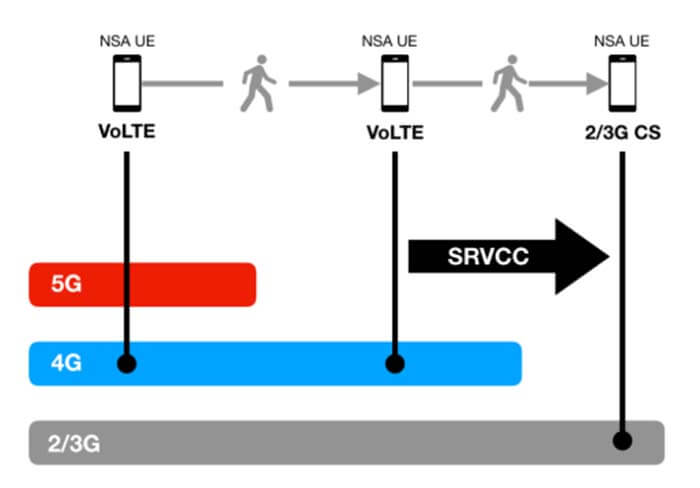
What is EPS Fallback (SA networking)?
Under SA networking, 5G networks have their own core network, 5GC, and no longer rely on 4G as the control network, which means that 5G voice services, i.e. VoNR (Voice over NR) or Vo5G (Voice over 5GS), can be carried independently end-to-end via 5G NR, 5GC and IMS.
However, in the early stage of 5G SA deployment, considering that the 5G NR network has not yet formed continuous wide coverage when the cell phone moves out of the 5G NR coverage area, it will frequently switch the ongoing VoNR voice to the VoLTE network with better coverage, which leads to poor user experience.
Therefore, a transition scheme, EPS Fallback, was introduced at the beginning of the 5G deployment.
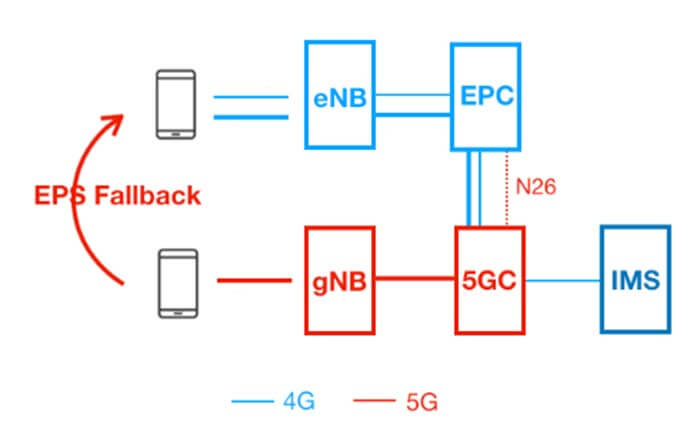
Similar to CS Fallback in the 4G era, under the EPS Fallback scheme, the 5G network does not provide PS voice services, and when the phone tries to use voice services in the 5G network, it will fall back to the 4G network by redirection or switching, and the 4G network will provide VoLTE voice services and return to the 5G network at the end of the call.
During the call, since the phone has fallen back to the 4G network, the data service is also forced to go through 4G LTE transmission together with the voice service until the call ends.
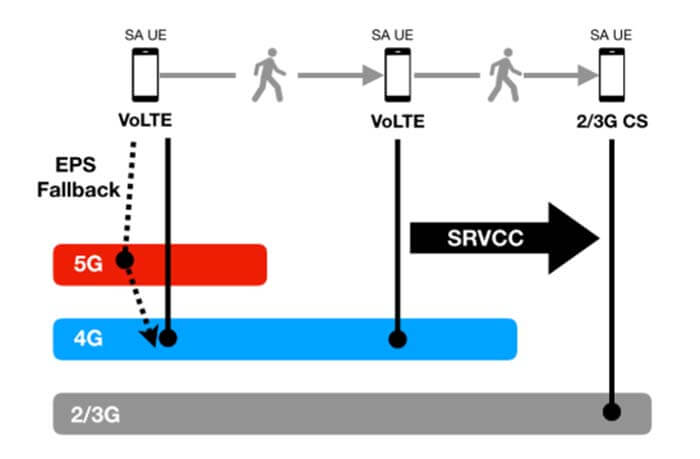
Obviously, in this scenario, since the fallback to 4G network is initiated when a voice call is established on NR, it will definitely increase the voice call establishment time; at the same time, the data traffic is also transmitted over 4G LTE during the call, which will also significantly reduce the data rate, thus affecting the user experience.
Although the fallback to 4G network will increase the call latency a little, VoLTE can provide a faster call setup time compared to CS voice fallback, and this additional latency is acceptable.
In fact, the biggest disadvantage of EPS Fallback is that, in addition to reducing data rates, it also causes a short voice connection interruption due to fallback to 4G, which is more noticeable to users than call setup latency.
What is 5G VoNR (SA networking)?
VoNR means voice services carried end-to-end by 5G NR, 5G Core, and IMS.
Strictly speaking, NR is only the radio access network part of the 5G network, while 5GS (5G System) contains 5G NR and 5G Core, so it is more accurate to call VoNR as Vo5G (Voice over 5GS). However, when we talk about VoNR, we usually mean Vo5G.
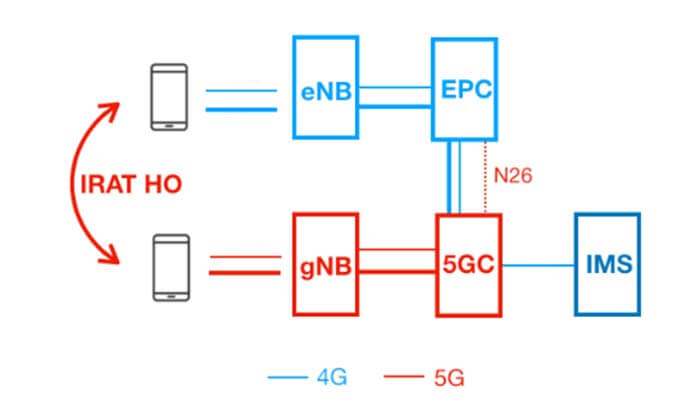
Compared with EPS Fallback, the advantages of VoNR are self-explanatory. First, we don’t need to fall back to VoLTE, so the call establishment time is shorter; second, it supports 5G voice and 5G data services concurrently, which means we can make a phone call while having high-speed 5G Internet access.
Considering that when the cell phone moves to the edge of 5G cell coverage, it will lead to poor VoNR voice quality or even dropped calls, in order to ensure the continuity of voice calls, it is necessary to switch the ongoing VoNR calls to 4G VoLTE.
Therefore, similar to the SRVCC solution in the 4G era, the VoNR solution also supports smooth switching between VoNR and VoLTE through the Inter-RAT handover mechanism.
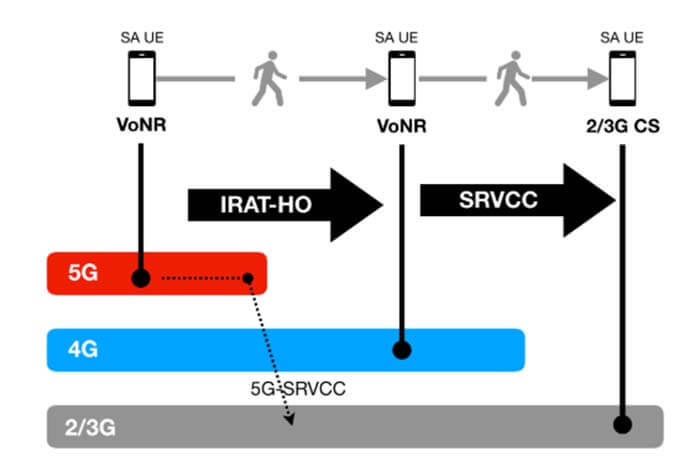
It is worth noting that with the introduction of 5G Core, the 5G R15 standard does not define the interface between 5G Core and 3G Core and does not support voice call continuity between 5G and 3G CS, which means that IMS/VoLTE must be supported in the R15 network with VoNR so that when the cell phone moves outside the 5G coverage area during a call, it can maintain call continuity through 4G VoLTE to maintain call continuity.
However, 3GPP has added 5G SRVCC capability in version R16, based on the existing 4G to 3G switching standard, which means that voice can be switched to the 3G CS domain via 5G SRVCC technology.
What are the benefits of 5G VoNR?
User experience and network efficiency at the same time
From the user’s perspective, as mentioned above, although VoNR continues the VoLTE architecture and can no longer achieve a revolutionary technological breakthrough, it has similar advantages to VoLTE, such as good voice call quality, low connection latency, and the ability to have 5G high-speed Internet access while talking.
For example, theoretically, VoNR has a MOS value of 4.6 and an access latency of only 1.5 to 2 seconds; VoLTE has a MOS value of about 4.1 and an access latency of 2 seconds, and 2/3G CS voice has a MOS value of 3.7 and an access latency of up to 6 seconds or more.
VoNR can also significantly improve the security of voice calls and the quality of video calls, as well as bring users a fully immersive experience with multi-sensory integration of voice and video, touch, and kinesthetic senses for the future.
From the operator’s perspective, the benefits of evolving to VoNR are mainly as follows.
First, VoNR can accelerate the transfer of traditional old and inefficient 2/3G CS voice to 4G and 5G, which can enhance network efficiency, reduce network operation and maintenance costs, as well as replant high-quality low-frequency resources.
Second, VoNR facilitates support for new 5G applications. The 5G applications we often mention today, such as AR/VR and holography, are inseparable from real-time, high-definition audio and video calls, and with VoNR, an enhanced media surface can be provided to better support these new applications.
Third, it can bring new revenue sources to operators. Although operators’ traditional 2C-oriented voice services have been subject to continuous erosion from OTT voice, voice services, as a basic communication business, are still part of operators’ revenue, and almost all current 5G data packages are bound with voice.
What’s more, for the digital transformation and the era of smart connection of everything, voice, and video services are extending from the connection between people to the vast market of connection between people and things.
In the future, in the 5G 2B or 5G private network market, there will be a large number of scenarios requiring real-time, high-quality, and highly stable audio and video communications, which are beyond the capability of best-effort OTT audio and video and require the deterministic guarantee capability of VoLTE/VoNR and ViLTE/ViNR based on IMS (slicing).
Yes, VoNR is a worthy technology to be introduced from both user and operator perspectives, and from both current network efficiency improvement and future business outlook.
It is important to mention that since VoNR is designed based on 4G IMS evolution and relies on VoLTE to ensure voice continuity, it is a basic requirement to introduce VoLTE first, which will be more challenging and urgent for those operators who have not yet commercialized VoLTE.
Besides the What is 5G VoNR Technology article, you may also be interested in the below articles.
What is the difference between WIFI and WLAN?
Summary of 41 Basic Knowledge of LTE
What Is The 5G Network Slicing?
